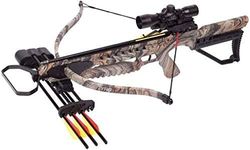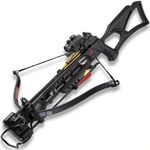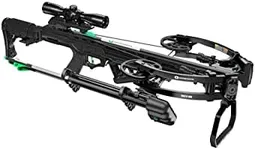Buying Guide for the Best Recurve Crossbows
Choosing the right recurve crossbow can be a rewarding experience, especially if you know what to look for. Recurve crossbows are known for their simplicity, reliability, and ease of maintenance. They are a great choice for both beginners and experienced archers. When selecting a recurve crossbow, it's important to consider several key specifications to ensure you get the best fit for your needs. Here are the main specs to focus on and how to navigate them.Draw WeightDraw weight refers to the amount of force required to pull back the string of the crossbow. This spec is important because it affects the power and speed of your shot. Draw weights can range from around 75 pounds to over 200 pounds. For beginners or those with less upper body strength, a lower draw weight (75-125 pounds) is recommended as it is easier to handle. Intermediate users might prefer a draw weight between 125-175 pounds for a balance of power and manageability. Advanced users or those hunting larger game may opt for a draw weight above 175 pounds for maximum power and penetration. Consider your physical strength and the type of game you plan to hunt when choosing the draw weight.
Arrow SpeedArrow speed, measured in feet per second (FPS), indicates how fast the arrow travels when shot from the crossbow. This is important for accuracy and effectiveness, especially in hunting scenarios. Arrow speeds typically range from 200 FPS to over 400 FPS. For target practice or small game hunting, a speed of 200-300 FPS is usually sufficient. For larger game or longer distance shooting, speeds of 300-400 FPS or higher are preferable. Your choice should be guided by the type of shooting you plan to do and the distance you expect to cover.
WeightThe weight of the crossbow itself is a crucial factor for comfort and ease of use. Crossbows can weigh anywhere from 5 to 10 pounds or more. Lighter crossbows (5-7 pounds) are easier to carry and maneuver, making them ideal for beginners or those who plan to move around a lot while hunting. Heavier crossbows (8-10 pounds) can offer more stability and may be preferred by experienced users who prioritize accuracy over mobility. Consider how long you will be carrying the crossbow and your ability to handle its weight comfortably.
Size and DimensionsThe size and dimensions of a recurve crossbow, including its length and width, affect its portability and ease of use. A more compact crossbow is easier to handle in tight spaces and can be more convenient for transportation. However, larger crossbows may offer better stability and accuracy. If you plan to hunt in dense woods or need to carry your crossbow over long distances, a more compact model might be best. For stationary shooting or open field hunting, a larger crossbow could be advantageous.
Noise LevelThe noise level of a crossbow when fired can be a critical factor, especially for hunters. Quieter crossbows are less likely to startle game, giving you a better chance of a successful shot. Noise levels can vary based on the design and materials used in the crossbow. If stealth is important to you, look for crossbows that are specifically designed to minimize noise, often featuring dampeners or silencers. For target practice, noise level may be less of a concern.
Ease of Assembly and MaintenanceRecurve crossbows are generally simpler to assemble and maintain compared to compound crossbows. However, the ease of assembly and maintenance can still vary between models. Look for crossbows that come with clear instructions and require minimal tools for assembly. Maintenance should also be straightforward, with easy access to parts that need regular care, such as the string and limbs. If you are new to crossbows, choosing a model known for its ease of use can save you time and frustration.













